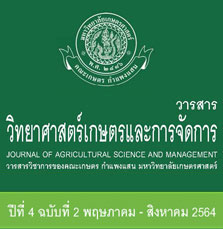การคัดแยกและจัดจำแนกแอคติโนมัยซีทจากดินที่มีฤทธิ์ในการกำจัดลูกน้ำยุงลาย
คำสำคัญ:
เชื้อแอคติโนมัยซีท, ยุงลาย, 16S rDNA, การวิเคราะห์สายสัมพันธ์เชิงวิวัฒนาการบทคัดย่อ
ยุงลาย ไม่เพียงแต่เป็นแมลงที่สร้างความรำคาญให้กับมนุษย์เท่านั้น แต่ยังเป็นพาหะนำโรคหลายชนิดสู่มนุษย์ด้วย วิธีการควบคุมหลากหลายรูปแบบถูกนำมาใช้กับยุงลายอย่างต่อเนื่อง วิธีการควบคุมโดยเชื้อจุลินทรีย์ หรือสารผลิตภัณฑ์จากจุลินทรีย์ เป็นวิธีการควบคุมที่กำลังมีบทบาทสำคัญ เพราะมีประสิทธิภาพสูง ใช้สะดวก และปลอดภัยต่อมนุษย์และสิ่งแวดล้อม วัตถุประสงค์ ของการศึกษานี้คือเพื่อคัดแยกและจัดจำแนกแอคติโนมัยซีทจากดินที่มีฤทธิ์ในการกำจัดลูกน้ำยุงลาย (Aedes aegypti) โดยเก็บตัวอย่างดินป่าในพื้นที่ จังหวัดแม่ฮ่องสอน จำนวน 2 พื้นที่ พื้นที่ละ 20 ตัวอย่าง คัดแยกเชื้อแอคติโนมัยซีทจากสารแขวนลอยดิน โดยวิธีเจือจางลดหลั่นต่อเนื่องและเทคนิคเกลี่ยลงบนอาหารเลี้ยงเชื้อ starch casein agar (SCA) เพาะเลี้ยงเชื้อในสารอาหารเหลว glucose yeast malt (GYM) 21 วัน สกัดหยาบอาหารเหลวที่ใช้เพาะเลี้ยงเชื้อด้วยเครื่องปั่นเหวี่ยงความเร็วสูง ที่ 10,000 รอบต่อนาที นาน 10 นาที เก็บส่วนของเหลวของอาหารเลี้ยงเชื้อ ปรับความเข้มข้นเป็น ร้อยละ 5 เพื่อใช้เป็นสารสกัดหยาบสำหรับทดสอบกับลูกน้ำยุงลาย วัยที่ 3 จำนวน 10 ตัว คัดเลือกไอโซเลตเชื้อที่พบว่าสารสกัดหยาบมีประสิทธิภาพในการกำจัดลูกน้ำยุงได้สูงสุด เพื่อศึกษาในอีก 2 ส่วน ส่วนที่ 1 ทดสอบประสิทธิภาพของสารสกัดหยาบจากอาหารเหลว 5 ชนิด คือ GYM, GYB, SY, ISP1 และ ISP3 ที่ใช้เพาะเลี้ยงเชื้อที่ผ่านการคัดเลือก กับลูกน้ำยุงลายวัยที่ 3 ส่วนที่ 2 ค้นหาเชื้อแอคติโนมัยซีทมี่มีความสัมพันธ์ใกล้ชิด โดยการวิเคราะห์สายสัมพันธ์ทางวิวัฒนาการจากสายพันธุกรรม ITS ของ 16S rDNA ผลการศึกษาพบเชื้อแอคติโนมัยซีทจำนวนทั้งหมด 195 ไอโซเลต จากตัวอย่างดินทั้งหมดที่เก็บรวบรวมจากพื้นที่ สารสกัดหยาบจากเชื้อไอโซเลต MSsm 007-6 เพียงชนิดเดียวที่มีผลต่อการตายของลูกน้ำยุงลายวัยที่ 3 ร้อยละ 50 ที่ 48 ชั่วโมงหลังสัมผัสสาร โดยสารสกัดหยาบจากอาหารเหลว GYM, Glucose Yeast และ SY ที่ใช้เพาะเลี้ยงเชื้อไอโซเลต MSsm 007-6 ที่มีประสิทธิภาพทำให้ลูกน้ำยุงตายในอัตราร้อยละ 73.3, 96.7 และ 63.3 ตามลำดับ ผลการวิเคราะห์สายสัมพันธ์ทางวิวัฒนาการด้วยวิธี Neighbor-Joining พบว่า สายพันธุกรรม ITS ของ 16S rDNA ของเชื้อไอโซเลต MSsm 007-6 มีความใกล้ชิดกับเชื้อ Streptomyces kasugaensis strain M338-M1 มากที่สุด โดยมีค่า bootstrap รองรับที่ร้อยละ 75
เอกสารอ้างอิง
ชนินทร์ สุริยกุล ณ อยุธยา, น้ำฝน ป้อมทอง, จรัญ เจตนะจิตร, พัชรี สุนทรนัน และ วิเชียร กิจปรีชาวนิช. 2546. เชื้อแอคติโนมัยสีทจากดินป่าเบญจพรรณ และป่าเต็งรังบริเวณสถานีวิจัยสัตว์ป่า เขานางรำ เขตรักษาพันธุ์สัตว์ป่าห้วยขาแข้ง. ใน: รายงานการประชุมวิชาการของ มหาวิทยาลัยเกษตรศาสตร์ ครั้งที่ 41 (สาขาวิทยาศาสตร์สาขาการจัดการทรัพยากรและสิ่งแวดล้อม).หน้า 363-370. กรุงเทพฯ: มหาวิทยาลัยเกษตรศาสตร์
พงศ์ระวี นิ่มน้อย. 2558. แอคติโนมัยซีท. สำนักพิมพ์มหาวิทยาลัยเกษตรศาสตร์, กรุงเทพมหานคร.
อรัญ งามผ่องใส, สนั่น ศุภธีรสกุล และ ธีรพล ศรีชนะ. 2559. องค์ประกอบทางเคมีและการปรับปรุงผลิตภัณฑ์น้ำมันเมล็ดสะเดาช้าง (Azadirachta exelsa Jack.) เพื่อควบคุมยุงลายบ้าน (Aedes aegypti Linnaeus). รายงานวิจัยฉบับสมบูรณ์ คณะทรัพยากรธรรมชาติ คณะการแพทย์แผนไทย และคณะเภสัชศาสตร์ มหาวิทยาลัยสงขลานครินทร์.
Altschul, S.F., W. Gish, W. Miller, E.W. Myers, and D.J. Lipman. 1990. Basic local alignment search tool.
Journal of Molecular Biology 215: 403-410.
Anupama, M. K.J.P Narayana and M. Vijayalakshmi. 2007. Screening of Streptomyces purpeofuscus for antimicrobial metabolites. Research Journal of Microbiology 2(12): 992-994.
Anwar, S., B. Ali, F. Qamar and I. Sajid. 2014. Insecticidal activity of actinomycetes isolated from salt range, Pakistan against mosquitoes and red flour beetle. Pakistan Journal of Zoology. 46(1): 83-92.
Balakrishnan, S., P. Santhanam and M. Srinivasan. 2016. Larvicidal potency of marine actinobacteria isolated from mangrove environment against Aedes aegypti and Anopheles stephensi. Journal of Parasitic Diseases Doi: 10.1007/s12639-016-0812-3.
Bond, J.G., C.F. Marina and T. Williams. 2004. The naturally derived insecticide spinosad is highly toxic to Aedes and Anopheles mosquito larvae. Medical and Veterinary Entomology 18: 50-56.
Christophers, R.S. 1960. Aedes aegypti (L.) the Yellow Fever Mosquito. The University Press, Cambridge (Brooke Crutchley, University Printer). 750 p.
Felsenstein J. 1985. Confidence limits on phylogenies: An approach using the bootstrap. Evolution 39: 783-791.
Ganesan, P., H.R. David, D.A. Reegan., R.M. Gandhi, G.M. Paulraj, S. Ignacimuthu and N.A. Al-Dhabi. 2017. Isolation and molecular characterization of actinomycetes with antimicrobial and mosquito larvicidal properties. Beni-Suef University Journal of Basic and Applied Sciences 6: 209-217.
Hall, T.A. 1999. BioEdit: a user-friendly biological sequence alignment editor and analysis program for Windows 95/98/NT. Nucleic Acids Symposium Series 41: 95-98.
Hamada, M., N. Kinoshita, S. Hattori, A. Yoshida, Y. Okami, K. Higashide, N Sakata and M. Hori. 1995. Streptomyces kasugaensis sp. nov.: a new species of genus Streptomyces. Actinomycetologica 9(1): 27–36.
Izquierdo-Suzán, M., S. Zárate, J. Torres-Flores, F. Correa-Morales, C. González-Acosta, E.E. Sevilla-Reyes, R. Lira, L.S. Alcaraz-Estrada and M. Yocupicio-Monroy. 2019. Natural vertical transmission of zika virus in larval Aedes aegypti populations, Morelos, Mexico. Emerging Infectious Diseases 25(8): 1477-1484.
Jayasinghe, B.A.T.D and D. Parkinson. 2008. Actinomycetes as antagonists of litter decomposer fungi. Applied Soil Ecology 38: 109-118.
Kumar, S., G. Stecher, M. Li, C. Knyaz and K. Tamura. 2018. MEGA X: Molecular evolutionary genetics analysis across computing platforms. Molecular Biology and Evolution 35(6): 1547-1549.
Lacey, A.L. 2007. The role of biological control of mosquitoes in integrated vector control. The American Mosquito Control Association Bulletin 23(7): 133-163.
Liu, H., S. Qin, Y. Wang, W. Li and J. Zhang. 2008. Insecticidal action of Quinomycin A from Streptomyces sp. KN-0647, isolated from a forest soil. World Journal of Microbiology and Biotechnology 24(10): 2243-2248.
Oliveira, R.S., T.R.R. Caleffe and H. Conte. 2017. Chemical control of Aedes aegypti: a review on effects on the environment and human health. Revista Eletrônica em Gestão, Educação e Tecnologia Ambiental - REGET e-ISSN 2236 1170. 21(3): 240-247.
Saitou, N. and M. Nei. 1987. The neighbor-joining method: A new method for reconstructing phylogenetic trees. Molecular Biology and Evolution 4(4): 406-425.
Singh, G and S. Prakash. 2012. Lethal effect of Streptomyces citreofluorescens against larvae of malaria, filaria and dengue vectors. Asian Pacific Journal of Tropical Medicine Doi: 10.1016/S1995-7645(12)60123-0.
Takizawa, M., R.R. Colwell and R.T. Hill. 1993. Isolation and diversity of actinomycetes in the Chesapeake Bay. Applied Environmental Microbiology 59(4): 997-1002.
Tamura, K. and S. Kumar. 2002. Evolutionary distance estimation under heterogeneous substitution pattern among lineages. Molecular Biology and Evolution 19(10): 1727-1736.
Tetreau, G., S. Grizard, C.D. Patil, F-H. Tran, V.T. Van, R. Stalinski, F. Laporte, P. Mavingui, L. Després and C.V. Moro. 2018. Bacterial microbiota of Aedes aegypti mosquito larvae is altered by intoxication with Bacillus thuringiensis israelensis. Parasites & Vectors. 11: 121.
Thavara, U., A. Tawatsin, T. Pengsakul, P. Bhakdeenuan, S. Chanama, S. Anantapreecha, C. Molito, J. Chompoosri, S. Thammapalo, P. Sawanpanyalert and P. Siriyasatien. 2009. Outbareak of chikungunya fever in Thailand and virus detection in field population of vector mosquitoes, Aedes aegypti (L.) and Aedes albopictus Skuse (Diptera: culicidae). Southeast Asian Journal Tropical Medicine Public Health 40(5): 951-962.
Thompson, J.D., T.J. Gibson, F. Plewniak, F. Jeanmougin and D.G. Higgins. 1997. The CLUSTAL_X windows interface: flexible strategies for multiple sequence alignment aided by quality analysis tools. Nucleic Acids Research 25(24): 4876-4882.
Wadetwar, N.R. and T.A. Patil. 2013. Isolation and characterization of bioactive actinomycetes from soil in and around Nagpur. International Journal Pharmaceutical Sciences and Research 4(4): 1428-1433.






